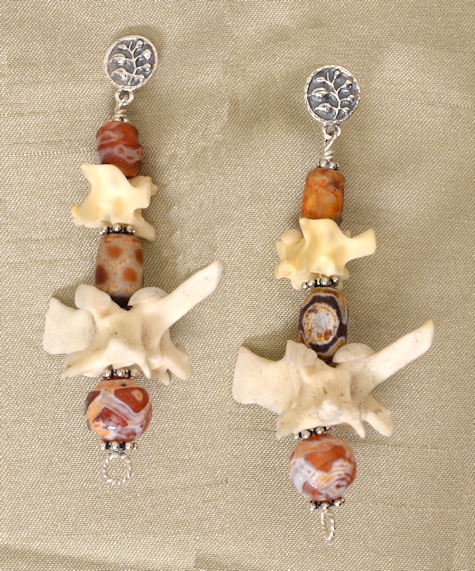Yes, these earrings are made with rattlesnake vertebrae. I am an ophiophile and would never hurt any snake. I hope the animal that donated its bones did not come to an untimely end, though I fear the worst. These poor creatures suffer from our ignorance and fear. It's very sad because they are incredibly interesting animals which play an important role in the ecosystem. The rattler is a viper and although viperids occur in the Americas, Africa and Eurasia, rattlesnakes occur only in the Western hemisphere.
The snake's highly sculptural vertebrae resemble our own, except that snakes may have over 200 of them, most derived from an extended thorax and so having ribs which protect the animal's internal organs. Furthermore, you may have noticed that the snake spine is rather more flexible than ours. In fact, the Wiki article on snake skeletons says, "the vertebrae of snakes articulate with each other by eight joints in addition to the cup-and-ball on the centrum, and interlock by parts reciprocally receiving and entering one another, like the mortise and tenon jointery [sic]." (Wonder what that writer was smoking?!) There is so much we could discuss about snakes if anybody besides me cared about them... have you ever wondered how the poor dears breathe when they are busy swallowing something that is bigger than their head? Or how they manage to swallow such a thing in the first place? Or we could discuss the different types of venom the poisonous snakes have developed, or the varieties of snake locomotion... Or we could get into snake lore and symbolism from cultures across the world. Perhaps when you wear these earrings you will be inspired to study the biology, ecology and lore of these amazing creatures. Who knows, you might become an ophiophile too...
A final note: when I was looking up books to include below, I suddenly remembered how I used to visit Klauber's massive two volume study of rattlesnakes at the San Diego Public Library when I was a little kid. I checked them out and read them, and later would swing by to look at them again and again. Dr. Klauber had an office in the Natural History Museum and I remember seeing him there a few times. Of course I was WAY too shy to talk to him. It's too bad, he must have been a fascinating character as the Wiki article about him describes. He even devised a triangular version of the Ulam spiral in 1932, 31 years before Ulam made his spiral.





